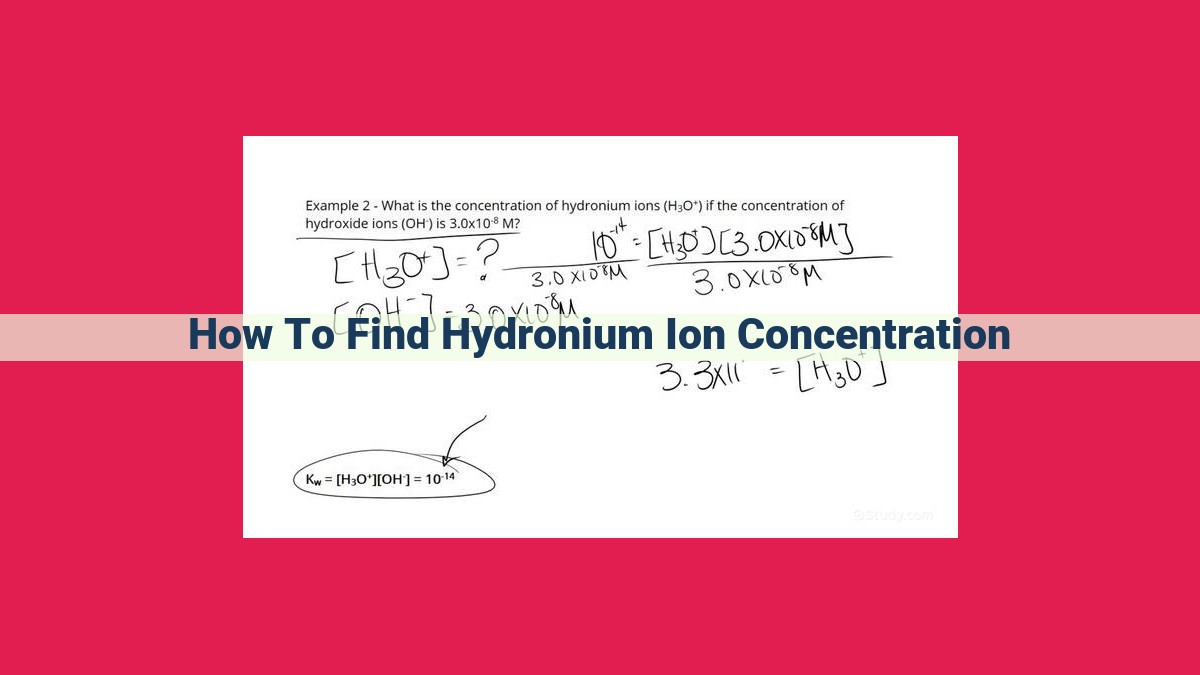[H3O+] Determination: Understanding Ph, Poh, Kw, And Their Inverse Relationships

To determine hydronium ion concentration ([H3O+]), utilize the pH scale, which ranges from 0 to 14. pH, pOH, and [H3O+] are inversely related, with [H3O+] calculated as 10^-pH. Alternatively, you can use pOH (14 – pH) to calculate [H3O+] as 10^-pOH. The ion-product constant for water (Kw) is essential, with Kw = [H3O+][OH-] = 10^-14. By measuring pH using pH meters or calculating it using equations, you can determine [H3O+]. This knowledge is crucial for understanding chemical reactions, titration analysis, and the acidity/basicity of solutions.
Unlocking the Secrets of the pH Scale: A Beginner’s Guide
pH, a ubiquitous term in chemistry, is a measure of the acidity or basicity of a solution. Understanding pH is crucial for comprehending chemical systems and their applications in various fields. In this guide, we will delve into the world of pH, exploring its definition, significance, and practical implications.
Exploring the pH Scale
The pH scale measures the concentration of hydronium ions ([H3O+]) in a solution, on a scale from 0 to 14. A pH of 7 indicates a neutral solution, while values below 7 represent acidic solutions (with higher [H3O+] concentrations) and values above 7 indicate basic or alkaline solutions (with lower [H3O+] concentrations).
The Relationship between pH, pOH, and [H3O+]
pOH is the opposite of pH, representing the concentration of hydroxide ions ([OH-]), and is calculated using the equation:
pOH = 14 - pH
The ion-product constant for water (Kw), with a value of 10^-14, establishes a direct relationship between [H3O+] and [OH-]:
Kw = [H3O+] * [OH-]
Calculating [H3O+] from pH
To calculate the [H3O+] concentration based on pH, we can use the equation:
[H3O+] = 10^-pH
For example, a solution with a pH of 3 has an [H3O+] concentration of 10^-3 M.
The Significance of Hydronium Ion Concentration: Understanding the Key Player in Acid-Base Chemistry
In the realm of chemistry, understanding pH and the concentration of hydronium ions ([H3O+]) is paramount. These concepts play a pivotal role in defining the acidity or basicity of solutions, influencing countless chemical reactions and everyday applications. Let’s delve into their significance and explore the relationship between these crucial elements.
Hydronium Ions: The Measure of Acidity
- Acidity and Basicity: [H3O+] is directly proportional to the acidity of a solution. Higher [H3O+] concentrations indicate greater acidity, while lower concentrations correspond to more basic solutions.
- The Key Relationship: The pH of a solution is inversely proportional to the [H3O+] concentration. The lower the pH, the higher the [H3O+] concentration, and vice versa.
pOH and Hydronium Ion Concentration
- Introducing pOH: pOH, the negative logarithm of the hydroxide ion ([OH-]) concentration, provides an alternative measure of solution properties.
- The Interdependence: pOH and pH are interrelated by the equation: pH + pOH = 14. With this relationship, you can determine [H3O+] concentration based on pOH, and vice versa.
Understanding the significance of hydronium ion concentration is crucial for comprehending chemical systems and predicting their behavior. By mastering these concepts, chemists and scientists unlock the ability to manipulate solutions, control reactions, and unravel the complexities of our chemical world.
The Ion-Product Constant for Water (Kw): A Guiding Principle for pH and [H3O+] Calculation
In understanding the intricate world of chemistry, we encounter the concept of the ion-product constant for water, denoted as Kw. This remarkable constant plays a pivotal role in determining the acidity or basicity of aqueous solutions.
Introducing Kw: The Key to Water’s Ionization
Kw is a numerical value that represents the equilibrium constant for the dissociation of water molecules into hydronium ions (H3O+) and hydroxide ions (OH-):
H2O <=> H3O+ + OH-
At a temperature of 25°C, the value of Kw is approximately 1 x 10^-14. This means that in pure water, the concentration of hydronium ions and hydroxide ions are equal, resulting in a neutral pH of 7.
Unveiling the Connection between Kw and [H3O+]
The ion-product constant for water serves as a guiding principle for determining the concentration of hydronium ions ([H3O+]) in aqueous solutions. This relationship is mathematically expressed as:
Kw = [H3O+] [OH-]
By utilizing this equation, we can calculate the [H3O+] concentration if the [OH-] concentration is known, and vice versa. This understanding provides a crucial tool for comprehending chemical reactions and their impact on pH.
The ion-product constant for water (Kw) acts as a cornerstone in the study of pH and [H3O+] concentration. Its value allows us to unravel the behavior of water molecules and their ionization in aqueous solutions. By grasping the interplay between Kw, pH, and [H3O+], we gain a deeper understanding of the chemical processes that shape our world.
Practical Applications of pH and Hydronium Ion Concentration ([H3O+])
Measuring Solution pH using pH Meters
pH meters are portable devices that measure the electrical potential in a solution to determine its pH. The meter’s probe contains a glass electrode that interacts with hydronium ions in the solution. The electrical potential between the probe and a reference electrode is then converted into a pH reading.
Calculating [H3O+] in Various Applications
Understanding hydronium ion concentration ([H3O+]) is crucial in various fields, including chemistry and biology. In chemical reactions, [H3O+] can influence reaction rates and product formation. In titration analysis, it is used to determine the concentration of an unknown acid or base.
Significance of Understanding pH, [H3O+], and [OH-]
Comprehending the interplay between pH, [H3O+], and hydroxyl ion concentration ([OH-]) is essential for understanding chemical systems. These parameters control the acidity, basicity, and equilibrium of reactions. For instance, in biochemical processes, maintaining a specific pH range is critical for enzyme function.
Applications in Everyday Life
The concepts of pH and [H3O+] extend beyond the laboratory. In agriculture, soil pH is key for plant growth. Water treatment involves adjusting pH to remove impurities and maintain water quality. Understanding these parameters empowers us to make informed decisions in various domains.